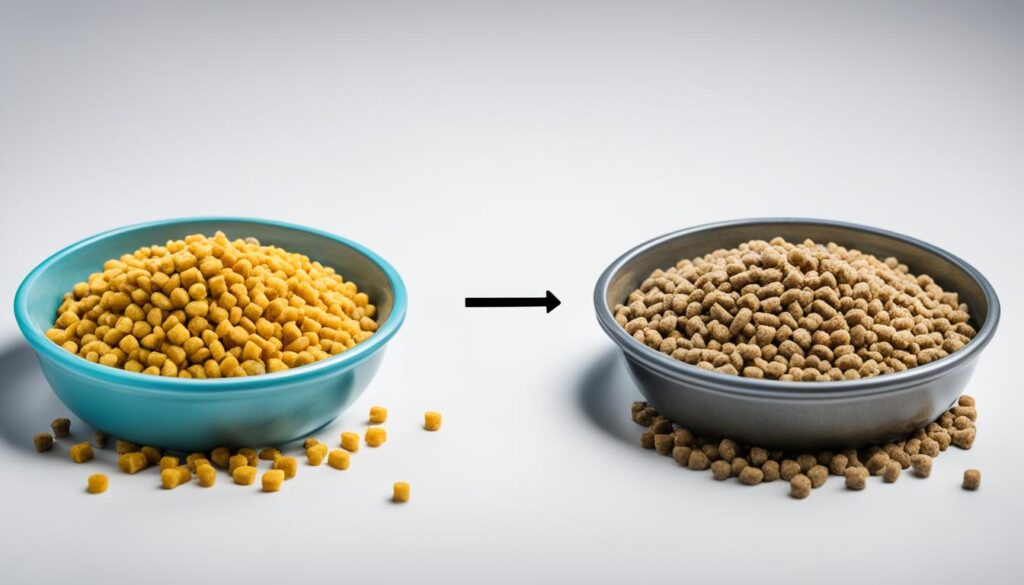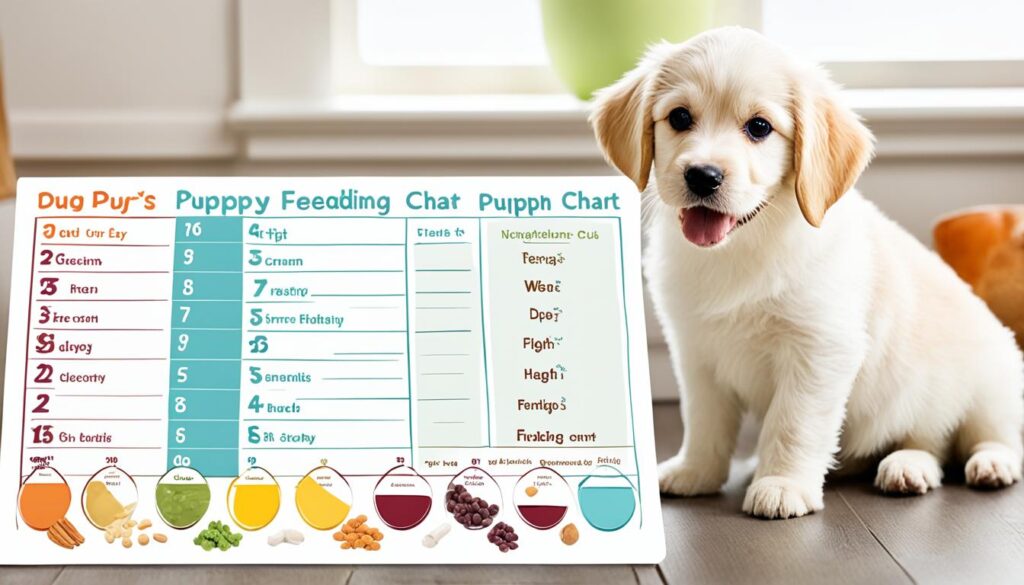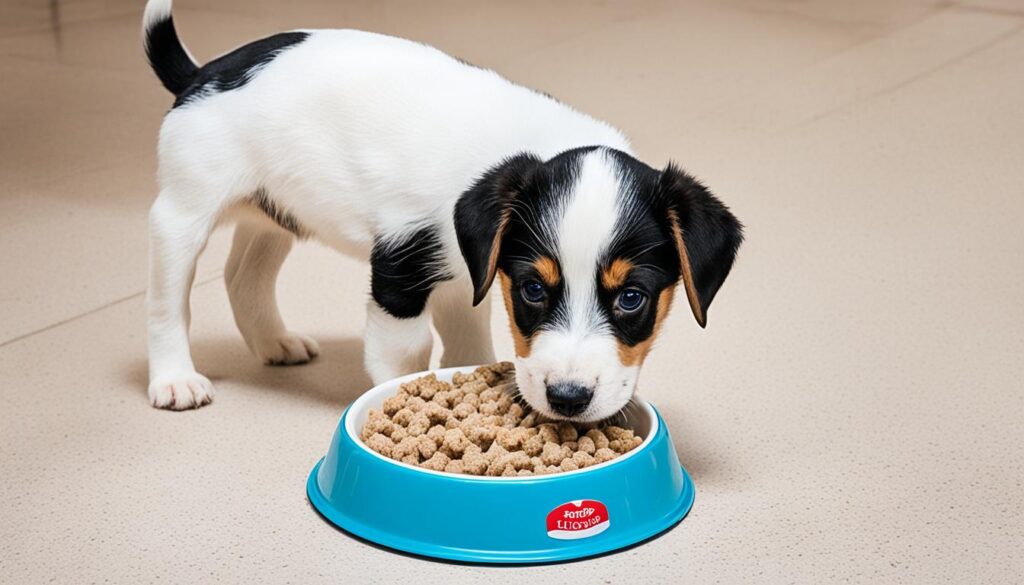Are you aware that puppies need double the amount of food per pound of body weight compared to adult dogs? Providing your furry companion with the correct portion of food is essential for their development and well-being. This quick guide offers all the necessary information to guarantee your puppy receives the right nutrition.
Key Takeaways:
- Feeding your puppy the correct amount of food is vital for their growth and well-being.
- Choose a high-quality puppy food that is complete and balanced.
- Consider breed size-specific formulas for optimal nutrition.
- Both dry and wet puppy foods are suitable options.
- Create a consistent feeding schedule for your puppy.
What to Feed a Puppy
Puppies need specific nutrition to support their growth and development. Feeding them a complete and balanced puppy food is essential. Look for formulas that are rich in high-quality proteins, fats, carbohydrates, calcium, and DHA to support their growing bodies, teeth, bones, brain, and vision development.
When it comes to choosing the right puppy food, there are various options available in the market. Here are some key factors to consider:
- Quality ingredients: Opt for puppy food that uses real meat as the primary ingredient and avoids fillers, artificial additives, and by-products.
- Age-appropriate formulas: Select puppy food specifically designed for their age group to meet their unique nutritional needs.
- Breed-specific formulas: Some brands offer breed-specific puppy food tailored to the requirements of certain breeds. These formulas take into account the size, energy levels, and potential breed-specific health concerns.
- Consult with your veterinarian: Your veterinarian can provide personalized recommendations based on your puppy’s specific needs, growth rate, and any potential health considerations.
Here is a table summarizing the essential nutrients and their benefits for puppy nutrition:
| Nutrient | Benefits |
|---|---|
| Proteins | Support muscle development and overall growth. |
| Fats | Provide energy, promote a healthy coat and skin, and aid in nutrient absorption. |
| Carbohydrates | Offer a source of energy and support digestion. |
| Calcium | Essential for bone and teeth development. |
| DHA | Aids in brain and vision development. |
Remember, it’s important to transition gradually when changing your puppy’s food. Start by mixing a small amount of the new food with their current food, gradually increasing the proportion over a week or two.
A healthy diet with the right balance of nutrients is the foundation of your puppy’s well-being. Providing them with a quality puppy food ensures they receive the essential nutrients needed for growth and development.

Feeding Puppies Large & Small
Feeding puppies of different breeds and sizes requires special consideration. Large breed puppies have unique nutritional needs that support their healthy growth and development, while small breeds may have specific requirements for easier chewing. Regardless of breed size, it’s crucial to provide complete and balanced food to ensure optimal nutrition for growing puppies.
Size-specific formulas are designed to cater to the specific needs of large and small breeds. These formulas are carefully formulated to provide the right balance of nutrients and are tailored to the size and growth rate of each breed.
“Proper nutrition is essential when raising puppies of different sizes. It’s important to choose size-specific formulas that provide complete and balanced nutrition to support their growth and development.”

| Breed Size | Nutritional Considerations |
|---|---|
| Large Breeds |
|
| Small Breeds |
|
By choosing the right size-specific formula, you can provide your puppy with the optimal nutrition they need for their size and breed. Consult with your veterinarian to determine the most suitable formula for your puppy.
Dry vs. Wet Puppy Food
Choosing the right type of puppy food can be a daunting task for any pet parent. When it comes to feeding options, the debate between dry and wet puppy food often arises. But fret not, both options have their advantages and it ultimately comes down to your puppy’s preference and specific needs.
Combination Feeding for Optimum Nutrition
One feeding option to consider is a combination of both dry and wet puppy food. By incorporating both types of food into your puppy’s diet, you can provide them with a variety of flavors and textures while ensuring they receive all the essential nutrients.
“Combining dry and wet puppy food is a great way to cater to your puppy’s taste preferences while ensuring their nutritional needs are met.”
However, it’s important to note that not all brands offer complete and balanced options in both dry and wet formulas. So before combining the two, make sure to choose high-quality puppy food that is specifically formulated for growing puppies, whether it’s dry, wet, or both.
The Benefits of Dry Puppy Food
Dry puppy food, also known as kibble, is the most common and convenient option for many pet parents. There are several benefits to feeding your puppy dry food:
- Convenience: Dry dog food is easy to store, measure, and serve, making it a practical choice for busy pet parents.
- Dental Health: The crunchiness of dry puppy food helps promote healthy teeth and gums by reducing tartar buildup.
- Long Shelf Life: Dry food has a longer shelf life than wet food, so you don’t have to worry as much about expiration dates.

The Advantages of Wet Puppy Food
Wet puppy food, also known as canned food, has its own set of advantages:
- Hydration: Wet food has a higher moisture content, which can help keep your puppy hydrated, especially if they don’t drink enough water.
- Taste and Aroma: Wet food is often more palatable to puppies due to its stronger aroma and robust flavors.
- Texture and Digestibility: The soft texture of wet food is easier for puppies to chew and digest, making it ideal for younger or smaller breeds.
Daily Caloric Calculation for Combination Feeding
When combining dry and wet puppy food, it’s crucial to calculate the total daily caloric value to ensure your puppy’s nutritional needs are met. The caloric value will depend on factors such as your puppy’s age, weight, activity level, and the specific brands and formulas you choose.
To determine the optimal feeding amounts, consult the feeding guidelines provided by the puppy food brands you select. These guidelines typically offer suggested feeding amounts based on your puppy’s weight and age. It’s also important to regularly monitor your puppy’s weight and adjust the portion sizes accordingly to avoid overfeeding or underfeeding.
| Food Type | Pros | Cons |
|---|---|---|
| Dry Puppy Food | Convenient, promotes dental health, longer shelf life | Lower moisture content |
| Wet Puppy Food | Hydrating, palatable, easier to chew and digest | Shorter shelf life, higher cost |
Remember, regardless of whether you choose dry, wet, or a combination of both, it’s crucial to select complete and balanced formulas that are specifically designed for growing puppies. Consult with your veterinarian to determine the best feeding options for your puppy’s individual needs and monitor their health and growth to ensure they thrive on their chosen diet.
How Much to Feed a Puppy
The amount of food your puppy needs depends on their weight at maturity. Different breeds have different nutritional requirements, and it’s important to feed them the right portion to support their growth and development. For example, a Labrador Retriever will require more food than a Russell Terrier.
To determine the appropriate amount of food for your puppy, consult the puppy feeding chart provided by your puppy food brand. This chart is designed to give you a guideline based on your puppy’s current weight and age. It will help you determine how much food to feed them each day.
In addition to the puppy feeding chart, it’s important to consider the specific feeding instructions on the package of your chosen puppy food brand. These instructions may provide additional guidance on the portion size and frequency of feedings.
Keep in mind that the puppy feeding chart and feeding instructions are general guidelines, and individual puppies may have specific needs. It’s always recommended to consult with your veterinarian for a customized feeding plan tailored to your puppy’s unique nutritional requirements.
Feeding Chart Example:
| Puppy Weight at Maturity | Daily Food Amount (Cups) |
|---|---|
| 2 – 5 pounds | 1/4 – 1/2 |
| 5 – 10 pounds | 1/2 – 1 |
| 10 – 20 pounds | 1 – 2 |
| 20 – 30 pounds | 2 – 3 |
| 30 – 40 pounds | 3 – 4 |
Remember, these are just general guidelines, and your puppy’s individual needs may vary. Monitor their weight and body condition to ensure they are receiving the appropriate amount of food.

When to Feed a Puppy
Creating a puppy feeding schedule is essential to establish a routine for your furry friend. Consistency in feeding times and dividing the total daily food amount into two to three smaller meals helps puppies adjust to a structured routine and aids in proper digestion.
Feeding your puppy early in the evenings allows them to digest their food before bedtime. This ensures a peaceful night’s sleep for both you and your pup.
| Feeding Tips: |
|---|
| 1. Consistent Meal Times: Establish consistent feeding times to regulate their appetite and avoid overfeeding. |
| 2. Divide the Food: Split the total daily food amount into two to three well-balanced meals throughout the day. |
| 3. Set a Schedule: Determine specific times for each meal to create a routine that your puppy can rely on. |

By following a consistent puppy feeding schedule, you not only ensure your puppy receives the nourishment they need but also have an organized routine that strengthens the bond between you and your furry companion.
When to Stop Feeding Puppy Food
The transition from puppy food to adult food is an important milestone in your pup’s development. Knowing when to make this transition depends on their breed size. Larger breeds require a longer period of puppy food, while smaller breeds can transition earlier.
Transitioning Based on Breed Size
When it comes to transitioning from puppy food to adult food, breed size plays a crucial role. Larger breeds typically have a slower growth rate and, therefore, need to continue with puppy food for a longer duration. On the other hand, smaller breeds mature faster and can make the switch to adult food at an earlier age.
As a general guideline:
- Larger breeds, such as Great Danes, Golden Retrievers, or German Shepherds, may need to stay on puppy food for up to two years.
- Medium-sized breeds, like Labradors or Border Collies, may transition to adult food between 12 to 16 months of age.
- Smaller breeds, including Chihuahuas or Yorkshire Terriers, can usually transition to adult food at around 10 to 12 months of age.
Consult Your Veterinarian for a Smooth Transition
It’s important to consult with your veterinarian to determine the right timing for the transition. They will consider your puppy’s individual needs, growth rate, and overall health. Additionally, your vet can provide valuable tips and guidance to ensure a smooth transition, minimizing any potential digestive issues or discomfort for your pup.
During this transition, pay attention to your puppy’s behavior, appetite, and any signs of digestive upset. If you have any concerns or questions, don’t hesitate to reach out to your veterinarian.
Keep in mind that a gradual shift from puppy food to adult food is recommended. Introduce the new food slowly, mixing increasing proportions of adult food with decreasing proportions of puppy food over a period of about a week. This gradual transition will allow your puppy’s digestive system to adapt to the new food without causing any major digestive issues.
Remember, every puppy is unique, and their nutritional needs can vary. Your veterinarian is the best resource to guide you through this essential transition and ensure the health and well-being of your growing pup.

| Breed Size | Transition Age |
|---|---|
| Larger Breeds | Up to 2 years |
| Medium-sized Breeds | 12 to 16 months |
| Smaller Breeds | 10 to 12 months |
What About Puppy Treats?
Treats can be a great way to reward your puppy for their good behavior and training progress. However, it’s crucial to follow the 90/10 rule to ensure your puppy’s overall health and balanced nutrition. The 90/10 rule means that treats should make up no more than 10% of your puppy’s daily calorie intake, with the remaining 90% coming from their complete and balanced puppy food.
To adhere to the 90/10 rule, it’s important to be mindful of the number and size of treats you offer your puppy throughout the day. By keeping treats limited, you can prevent excessive calorie intake and maintain a healthy weight for your furry friend.
When selecting puppy treats, opt for healthy options that are specifically formulated for puppies. Look for treats made from high-quality ingredients, free from artificial colors, flavors, and preservatives. It’s also a good idea to choose treats that promote dental health by helping to reduce plaque and tartar buildup. Remember to avoid feeding your puppy human food, as some ingredients can be harmful to dogs.
Rewards play an important role in your puppy’s training process. Use treats to reinforce positive behaviors, such as sitting, staying, or going potty outside. Pairing verbal praise with treats helps your puppy associate good behavior with positive experiences, strengthening their training progress. Keep in mind that training treats should be small, easy to chew, and low in calories to prevent overfeeding.
Top Tips for Treating Your Puppy:
- Select healthy puppy treats that are specifically formulated for their nutritional needs.
- Choose treats that promote dental health and help reduce plaque and tartar buildup.
- Limit treats to no more than 10% of their daily calorie intake.
- Use treats as rewards during training sessions to reinforce positive behaviors.
- Pair verbal praise with treats to strengthen the association between good behavior and positive experiences.
- Avoid feeding your puppy human food, as some ingredients can be harmful to dogs.
By following these guidelines and incorporating treats mindfully into your puppy’s diet, you can ensure they receive the rewards they deserve while maintaining a healthy and balanced nutritional intake.

How to Bottle Feed Puppies
When it comes to caring for orphaned or abandoned puppies, bottle feeding is an essential skill to have. Whether you’re a foster caregiver or a breeder assisting with hand-rearing, bottle feeding ensures that these helpless little ones receive the nutrition they need to thrive. Here’s a step-by-step guide on how to bottle feed puppies:
- Purchase a milk replacer specifically made for puppies. These formulas are designed to provide the necessary nutrients for their growth and development.
- Follow the instructions on the package for reconstituting the milk replacer. It’s crucial to mix it accurately to achieve the proper consistency.
- Warming the bottle is important, as the warmth mimics the mother’s body temperature and makes the milk more appealing to the puppies.
- Hold the bottle at a 45-degree angle to allow the milk to flow smoothly. Ensure that the nipple is filled with milk while avoiding excessive air intake.
- Position the bottle’s nipple near the puppy’s mouth and let them suckle at their own pace. Be patient and gentle during the process.
- Newborn puppies have small stomachs and need frequent feedings, typically every 2-4 hours. As they grow, the frequency of feedings can gradually decrease to every 4-6 hours.
- Consult with your veterinarian for guidance on developing a feeding schedule that suits the puppies’ age, size, and condition. Every puppy is unique, and professional advice is invaluable.
- Monitor the puppies’ weight closely to ensure they are gaining appropriately. Weight gain is an important indicator of their overall health and development.
Bottle feeding puppies requires patience, dedication, and careful attention to their needs. Remember that it’s always best to consult with a veterinarian for detailed guidance and support throughout the process.

The Benefits of Bottle Feeding
Bottle feeding puppies has numerous benefits. It allows for individual monitoring of each puppy’s food intake, ensuring that no puppy is left without nourishment. Additionally, it promotes a close bond between the caregiver and the puppies, as they associate feeding time with comfort and warmth. Bottle feeding also provides an opportunity to closely observe their health and address any concerns promptly.
How Much to Feed a Puppy After Weaning
Once puppies are fully weaned, it’s important to continue monitoring their diet and weight to ensure they remain healthy. Feeding them the right amount of food is essential for their growth and development. Follow these guidelines to determine the appropriate daily calorie intake for your puppy.
Feeding your puppy after weaning should be based on the instructions provided by your veterinarian and the puppy food label. These guidelines will help you determine the appropriate portion sizes for your puppy.
Determining the Daily Calorie Intake
The daily calorie intake for a puppy will vary depending on their weight, body condition score, and activity level. It’s essential to adjust the amount of food accordingly to prevent overfeeding or underfeeding. Your veterinarian can provide specific recommendations tailored to your puppy’s needs.
A general rule of thumb is to feed puppies 2-3% of their body weight in solid food per day. However, this can vary depending on factors such as breed, metabolism, and individual differences.
Quote: The daily calorie intake for a puppy will vary depending on their weight, body condition score, and activity level.
Monitoring Your Puppy’s Weight
Regularly monitor your puppy’s weight to ensure they’re growing at a healthy rate. If you notice significant weight gain or loss, adjust their food portions accordingly. A body condition score chart can help you assess your puppy’s overall body condition, including their weight.
Preventing Overfeeding
Overfeeding can lead to obesity and other health issues in puppies. It’s important to practice portion control and avoid giving excessive treats or additional food outside of their regular meals. Stick to the recommended daily calorie intake based on your puppy’s needs.
Preventing Underfeeding
On the other hand, underfeeding can lead to nutrient deficiencies and stunted growth. Ensure you’re providing enough food to meet your puppy’s energy requirements and promote proper development.
Example Puppy Feeding Schedule
Here’s an example puppy feeding schedule to give you an idea of how to divide the daily calorie intake into meals:
| Time | Meal | Portion Size |
|---|---|---|
| 8:00 AM | Breakfast | 1/3 of recommended daily intake |
| 12:00 PM | Lunch | 1/3 of recommended daily intake |
| 6:00 PM | Dinner | 1/3 of recommended daily intake |
Remember to adjust the portion sizes based on your puppy’s specific needs and activity level. Consulting with your veterinarian is crucial to ensure your puppy stays on a healthy feeding plan.

Conclusion
Feeding puppies the right amount of food is crucial for their growth and overall health. This puppy feeding guide has provided you with the necessary information to ensure that your furry friend receives the proper nutrition.
By following the guidelines outlined in this guide, consulting with your veterinarian, and choosing a high-quality, complete, and balanced puppy food, you can rest assured knowing that you are providing your puppy with the best start in life.
Remember, each puppy is unique, and their nutritional needs may vary based on breed, size, and individual requirements. Regularly monitor your puppy’s weight, body condition, and adjust their food portion accordingly. With proper feeding and care, you can ensure that your puppy grows into a healthy and happy adult dog.










